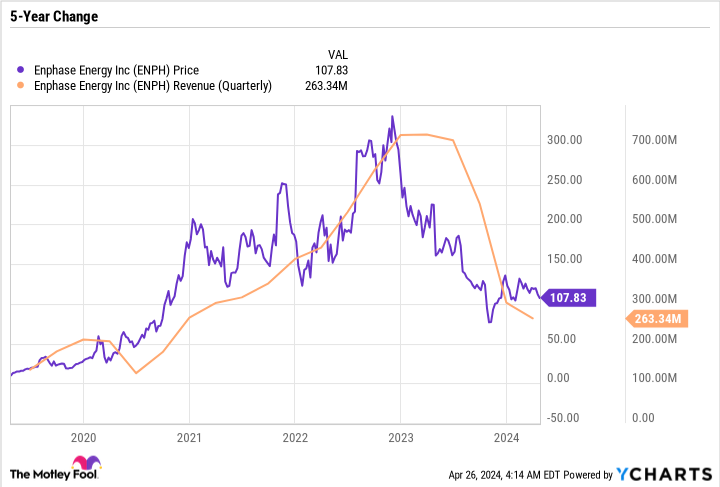The renewable energy stock remains a risky bet.
Enphase Energy (ENPH 7.67%) remains under pressure and bogged down by an industrywide slowdown in the solar market. After a 50% decline in 2023, the stock is down over 18% in 2024, which is a particularly bad look relative to a strong performance in the S&P 500.
The same factors that made Enphase a Wall Street darling have turned against the company, showcasing the dangers of investing in cyclical stocks.
Here’s why the narrative is negative on Enphase, and what the company needs to do to turn things around.
Image source: Getty Images.
Bust, to boom, to bust again
Investors who have followed Enphase for a while are familiar with peaks and troughs in its performance.
Five years ago, Enphase generated $100 million in sales and a slight profit of $2.8 million. The company was coming out of a multiyear slowdown (and nearly going bankrupt), but growth was accelerating, and Enphase was charting a path toward profitability. The next few years were explosive, and investors were rewarded with a several-fold increase in the stock price.
But times have changed. Enphase’s recent quarter (Q1 2024) showed the severity of the slowdown, with revenue coming in at just $263.3 million — the low end of the forecast range of $260 million to $300 million and a brutal 63% decline from the $726 million in revenue Enphase earned in Q1 2023. It was the lowest quarterly revenue for Enphase since Q3 2020 and the first time the company reported a quarterly net loss since Q2 2020.
A broken growth story
The Enphase investment thesis has centered around sales growth paired with high margins. Many companies can grow their sales but face declining margins as they become more complex. However, the best companies can become much larger while retaining or even growing margins, one of the most powerful combinations an investor can find.
A good example is Microsoft, which is generating all-time-high sales and an operating margin of around 44% compared to the low 30% range a decade ago. So, the business is more efficient despite being much larger.
What made the Enphase investment thesis so compelling is that the company had explosive growth and high margins despite selling hardware components. Enphase mainly sells microinverters for residential solar systems, which convert the direct current produced by panels from the sun and turn it into the alternating current we use in our homes. It’s a necessary part of the system but not the kind of component you would think would be ultra-high margin. After all, companies that sell physical products generally have lower margins than software companies. But Enphase had defied that construct.
Throwing fuel on a scorching hot growth story was the rapid excitement of the energy transition and solar’s growing share of the energy mix. The long-term tailwinds of the energy transition remain intact, but higher interest rates have acted like a bucket of water on the red-hot narrative. Higher borrowing costs reduce the return on investment for solar and make installing a solar system more expensive and less appealing. This is a particularly big risk to Enphase since it focuses mainly on the residential market. The commercial market has also slowed, but companies may still go through with utility-scale solar projects if they are in line with company and regulatory agency objectives.
Hit the pause button on Enphase
Enphase is a good example of how the metrics that fuel an outperforming stock can be the same factors that lead it to underperform the market. Revenue growth, high margins, improving profitability, and a strong trajectory that growth would continue and margins would stay high pole-vaulted Enphase stock to new heights. But now, collapsing revenue and net losses are what is dragging Enphase down.
Enphase is a difficult stock to value because of uncertainty. Management is confident that the recent quarter was the low point in the downturn and that the business will begin to recover in Q2, especially the second half of this year. But we don’t know what the recovery will look like, and it seems doubtful that Enphase will be able to return to the same pace of growth in this high-interest-rate environment. Although the Federal Reserve could begin cutting rates later in the year, we don’t know how many rate cuts it will issue. Even in the medium term, rates could stay at higher levels than pre-pandemic as long as inflation gets closer to the Fed’s goal of 2%. In that scenario, Enphase could return to a slower, less breakneck growth rate.
Investors should be careful not to view Enphase as a pure interest-rate story and assume that when rates come down, the company will flip a switch and revert to blistering growth. However, we should learn a lot more in the coming quarters about what the recovery looks like and whether the worst is truly behind Enphase.
Daniel Foelber has the following options: long July 2024 $130 calls on Enphase Energy. The Motley Fool has positions in and recommends Enphase Energy and Microsoft. The Motley Fool recommends the following options: long January 2026 $395 calls on Microsoft and short January 2026 $405 calls on Microsoft. The Motley Fool has a disclosure policy.




